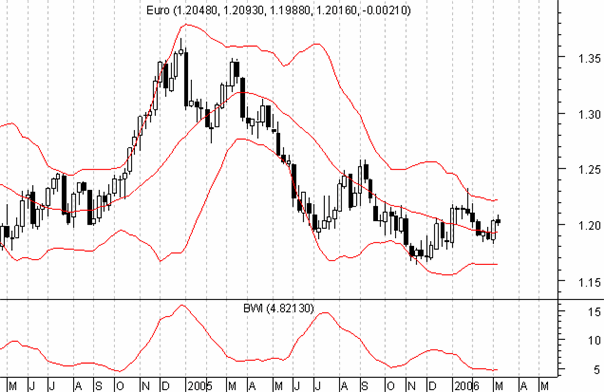Lots of action, but little direction
The last week or so has seen some of the most forceful EUR/USD trading
witnessed for a while. Four of the last six sessions have had trading
ranges of around 100 pips or better, after a long stretch during which that was
a rarity. Those who are day traders have probably quite enjoyed the
increased volatility, and perhaps the swing traders have as well. We
should not, however, get overly excited from a longer-term perspective just yet.
Take a look at the weekly chart below. The Bollinger Band study has been included to provide a guide to overall
price volatility in the longer-term timeframe. To put it simply, when the
Bollinger Bands are wide, the market has seen a lot of price movement, while
narrow Bands suggest relatively quiet trading.

To provide for easy
comparison, the Band Width Indicator (BWI) has been included in the lower plot.
The BWI line is simply a measure of how wide the Bands are relative to the
middle band. In this case, we are using 20-days for the Bollinger Bands,
so the middle Band is the 20-day moving average. The BWI allows us to
quickly compare the current width of the Bands against its history.
In the case of weekly EUR/USD, we can see that BWI has gotten very low on a
relative basis. In fact, we have to look back to October 2004 to find a
similarly low reading as currently seen. This means EUR/USD is going
through a very low volatility period. The expectation is that this will
change.
Following that 2004 low BWI reading the market rallied about 1500
pips over the next few months, after all. The problem, however, is that we
really need to see the Bands start to widen out before we can look for the next
major trend to develop. This has been observed in research done recently
which indicates that low BWI readings by themselves actually indicate lower
volatility, but when BWI starts moving back up in a meaningful fashion things
start getting very interesting.
The long and short of it is that for the time being we have to consider the
longer-term situation in EUR/USD to be one of consolidation. That should
be factored in to the shorter-term trading we do.
John Forman is the author of
The Essentials of Trading
(Wiley) and a near 20-year veteran of trading and investing across a wide array
of markets and instruments. His analysis and market comments have been found in the financial news media across the world and he has published dozens of
magazine articles on trading methodology and analytic technique. To learn more about John’s research and trading activities, visit the
Anduril Analytics website.
